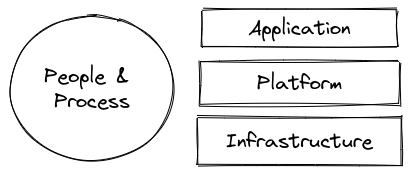Reading Notes: Learning Chaos Engineering
Chaos Engineering was introduced at Netflix to test the reliability of their platform. It has since gained traction in large tech companies. On the surface, it consists of injecting faults and verifying that everything goes according to plan. There's a lot more to it. In Learning Chaos Engineering, Russ Miles introduces the discipline through the practical approach.
Software system
Chaos engineering subject is the software system. It consists of the infrastructure, the platform, the application, and the process/people.

Chaos engineering can test each of these aspects.
Following the Chaos Learning Loop, you can learn a lot on your system. It consists of the following steps:
- Explore: list hypothesis on your system ("Can it fail when an availability zone is down?", "Can we put the system back on its feet when Alice is not here?", etc.)
- Discover: experiment on your system
- Analyze: the results might confirm your hypothesis or not
- Improve: introduce remediation measures
- Validate: test your remediation measures
- Repeat: go back to step 1
The book presents multiple examples of how to run this loop. It also suggests multiple approaches to run each step correctly.
First, you need to collect hypotheses. Most likely you won't have a single hypothesis. And since everyone will have an idea, you need to prioritize. I would think a RICE would be good enough. Russ suggests using an even simpler format: likelihood vs impact.
Once you have a hypothesis log, let's learn more about your system! But not in a chaotic way. Chaos engineering emphasizes applying a scientific approach.
- Describe the steady-state hypothesis: metrics that make sure the system behaves normally
- The turbulent condition-inducing agent: it create chaos in your system
- The mitigation measures to stop the chaotic agent
- Experiment reporting: a way to track what happened during the experiment
Once you conceive all these tools, let's play the experiment.
Firstly, check the steady-state hypothesis. If it's not normal, it means that your system is already not behaving as you expected. Abort the experiment and think about your hypothesis again.
Secondly, Introduce the chaotic agent. Your reporting measures the steady-state hypothesis until the agent is done.
Finally, you have a report in your hands that you can pass to your analysis step.
Conclusion
Chaos Engineering is empirical engineering at its best. It is not magic thinking. It confronts hypotheses and plans to reality. Yet, it's not chaotic, it's very organized and disciplined!
The book uses a lot the word "turbulent". Turbulence appears when systems are under high constraints, which is not the case for every company. This technique took off in big companies, where reliability is key.
Our way of building software can benefit from the philosophy of Chaos engineering. It would advocate for "Just Enough Design" and empirical approaches. Instead of solving virtual issues, you first measure to prove problems exist. Only then can you think of solutions to mitigate them.
Take care.
